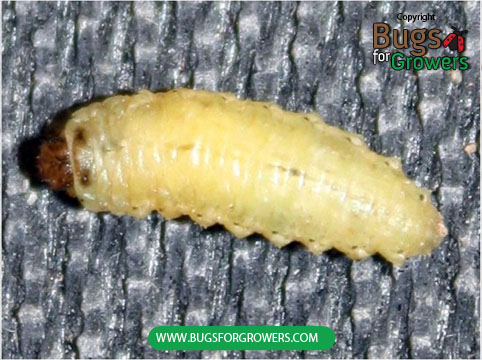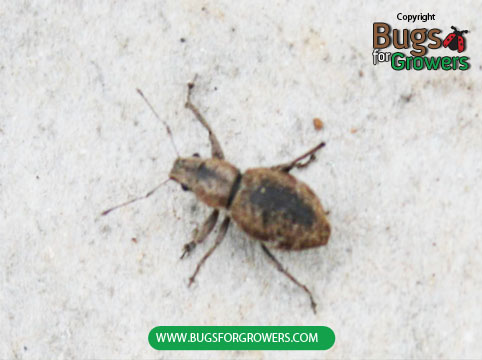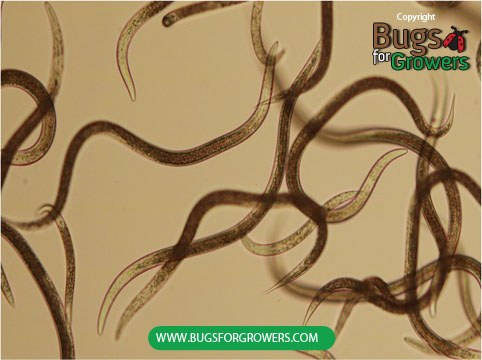Eight weevils can be controlled with steinernema carpocapsae nematodes- Bugs For Growers
What are weevils?
Like other beetles, weevils belong to an insect order Coleoptera but unlike other beetles, they have a distinct narrow beak or rostrum extending in front of their heads with chewing mouthparts are located at the tip of rostrum. Several species of weevils that have been described so far are considered as the most serious pests of many plant species including field and fruit crops, ornamentals, forest trees and turf grasses. The common names that are assigned to different species of weevils are usually associated with the common names of their host plants (see below). Also, the sizes and colors of both grubs also called as larvae (Photo 1) and adults (Photo 2) generally differ with their species. Following eight species of weevils can be controlled with beneficial entomopathogenic nematode, Steinernema carpocapsae nematodes.


Alfalfa weevil, Hypera postica
Adult weevils are light brown in color with a broad darker stripe extending down their midline. Young larvae of alfalfa weevils are tiny and yellowish green with black heads whereas their older larvae are greenish in color with black heads and a distinct white line down the center of their backs and white lines along each side of body. Although both adults and larvae of alfalfa weevils cause damage to alfalfa leaves, the damage caused by larvae is more severe than the damage caused by adults. In case of sever infestation, larvae can completely defoliate the plants and reduce the yields. Although all the stages including eggs, larvae, pupae and adults of alfalfa weevil are completed on the plants, sometime their mature larvae can pupate in the leaves that are fallen to the ground. So these mature larvae and pupae that are fallen to the ground can be targeted with beneficial entomopathogenic Steinernema carpocapsae nematodes.
Annual bluegrass weevil, Listronotus maculicollis
The annual bluegrass weevil prefers to feed mainly on annual bluegrass (Poa annua) compared to any other grass species and therefore they are named as annual bluegrass weevils. The larvae of blue grass weevil are creamy white and legless whereas adults are black colored with small hairs and gold scales on their forewings (elytra). Although both adults and larvae (grubs) of annual bluegrass weevil cause damage to turf grass, their larvae cause the most severe damage to annual bluegrass. Overwintering adults become active early in the spring and start feeding on the grass leaves and mate. The eggs laid by female weevils hatch early in the May into young larvae that start feeding by tunneling into grass stems. The symptoms of damage caused by bluegrass weevil include yellowing of grass leaves and subsequently dying of grass. Matured grubs generally move out of the tunnels and begin feeding externally on the surface of stems, crowns and roots of grass. In case of severe infestation, they can cut off stems from roots causing complete drying and loss of turf grass. Then mature larvae move in the soil for pupation. Both mature larvae and pupae can be easily targeted with Steinernema carpocapsae nematodes.
Billbugs, Sphenophorous parvulus, S. cicastriatus
The billbugs are weevils but they are commonly called as snout beetles. Although billbugs prefer Kentucky bluegrass, they also feed on perennial ryegrass, tall fescue, corn, rye and wheat. Adult weevils are blackish or greyish in color with elbowed antennae and distinct grooves running longitudinally down their forewings. Billbug grubs are legless, cream in color with brown head capsules and slightly curved body. Overwintering billbug adults emerge out from their hiding places in April and start feeding on the grass leaves. Female billbugs then lay eggs inside a hole chewed by them in the stem near the base of the turf plant. After hatching from eggs, young larvae generally move towards crown and roots by burrowing through the grass stem. These grubs will then feed voraciously and completely damage the crowns and eventually kill the entire grass plant. Damage by billbugs generally starts appearing as irregular mottling or thinning patches of the turf in mid-June through August. As both larval and pupal stages of billbugs found in the soil, they can be easily killed with Steinernema carpocapsae nematodes.
Black vine weevil, Otiorhynchus sulcatus
The black vine weevils are considered as one of the most damaging insect pests of many nursery and landscape plants. Adult weevils are black or gray in color with elbowed antennae and a prominent short snout. Fully-grown grubs are C-shaped, legless and whitish in color with brown head capsules. Although both adults and larvae of black vine weevil cause direct damage to host plants, adults mostly feed on foliage and flowers whereas larvae (grubs) feed on the roots. Feeding damage caused by adults can be easily recognized because of a typical notched appearance of damaged leaves or flowers. Adult weevils also feed on the developing young buds and shoots. Larvae of black vine weevils cause a serious damage to roots of different host plants. Heavy infestation of black vine weevil can kill the entire plant. Since all the larval stages and pupae live in the soil, they can be easily found and killed by entomopathogenic nematodes like Steinernema carpocapsae nematodes.
Red palm weevil, Rhynchophorus ferrugineus
The red palm weevil is considered as one of the major pest of palms in the Mediterranean Basin but they can be considered as a serious threat to date production in California. Adult weevils are reddish brown in color with a long curved rostrum (snout) and dark spots on the upper side of the middle part of the body whereas their larvae are white in color with a brown head capsule. Damage to palms is mainly caused by the larvae and only becomes visible long after infestation. By the time the first symptoms of the pest infestation are noticed, the palm plants are already so seriously damaged that they cannot survive. As mature larvae of red palm weevil move in the leaf litter at the base of tree trunk for pupation, both larvae and pupae can be targeted and killed with Steinernema carpocapsae nematodes.
Strawberry root weevils, Otiorhynchus ovatus
The strawberry root weevils are one of the most serious insect pests of strawberry crop. Adult weevils are reddish brown to black in color whereas their larvae are creamy white in color, C-shaped, legless with tanned heads. Adults of strawberry root weevil feed on the edges of strawberry leaves (notching of leaves) whereas all of their larval stages cause feeding damage by tunneling in the roots and crowns. The main symptoms of damage caused by larvae of strawberry weevils include pruning of roots, weakening, stunting of plant growth and eventually killing of entire plants. As both larvae and pupae of Strawberry root weevils, Otiorhynchus ovatus live in the soil; they are easy target for entomopathogenic nematodes.
Citrus root weevil, Diaprepes abbreviates
The citrus root weevil is one of the major insect pests of citrus and many ornamental plants in California and Florida. Adults of citrus root weevil are black in color with small white, red, orange or yellow colored scales on the forewings (elytra). The larvae (grubs) are white and legless with light head capsule. Adults cause leaf notching by feeding on the margins/ edges of leaves. The larvae of citrus weevil mainly feed on the roots of their hosts. In the severe cases they can girdle main roots that can result into death of citrus trees. As all the larval stages and pupae of the citrus root weevil live in the soil, they can be easily controlled with the application of entomopathogenic nematodes like Steinernema carpocapsae.
Pecan weevil, Curculio caryae
The pecan weevil is considered as one of the most devastating pest of pecans. The adults of pecan weevils are brown to grey in color with a characteristic snout, as its length is equal to the length of weevil’s body. Larvae of the pecan weevil are creamy white in color with reddish head capsule. The adults of the pecan weevil will emerge from pupae in the soil, then they will move out of the soil into the tree canopy either by crawling on the tree trunk or directly flying in August through September. Once in the canopy, adult weevils begin feeding by puncturing young developing nuts that will fall off the trees prematurely within 2-3 days. While feeding adult weevils mate. The mated females then lay eggs inside the nuts by chewing a hole into its hardened shell. After hatching from eggs inside the nut, larvae start feeding immediately on a developing kernel and mature within 2-3 weeks. When the damaged nuts fall to the ground, the mature larvae exit the nuts by cutting a small circular hole in the shell and then burrow into the soil and pupate. Three weeks after pupation, adult weevils emerge in August. It takes about 2-3 years for pecan weevils to complete their life cycle. Since all the mature larval, pupal and adult stages of pecan weevil live in the soil under pecan tree, they can be easily targeted by pre-emergence applications of beneficial entomopathogenic nematodes in early May, June and in late June or in early July.
Biological control of weevils with Steinernema carpocapsae nematodes
Because of cryptic habitats of weevils, their management with chemical insecticides is difficult. During completion of entire life cycle at least one stage (either adult, larva or pupa) of almost all the above stated species of weevils lives in the soil and this soil dwelling stage can be easily targeted and killed with the inundative application of beneficial entomopathogenic nematodes. Entomopathogenic nematodes including Steinernema carpocapsae have been proved to be the best biological control agents to manage weevils that infesting different crops. It has been demonstrated that S. carpocapsae nematodes when applied at the rate of 23000 nematodes per square foot or 1billion nematodes per acre, they can cause between 50 and 100% mortality of many weevil species including alfalfa weevils, annual bluegrass weevils, black vine weevils, citrus root weevils, large pine weevils, pecan weevils, red palm weevils and strawberry root weevils (Abbas, et al., 2001; Ansari and Butt, 2011; Dembilio et al., 2010; Duncan et al., 1996; Lacer et al., 2009; McGraw et al., 2010; Shah et al., 2011; Schroeder, 1992, Simser and Roberts, 1994).
How does Steinernema carpocapsae Nematode Kill Weevils?
Beneficial Steinernema carpocapsae nematodes are parasites of insects and most effective against soil-dwelling stages of many insect pests including weevils at temperatures ranging from 22 to 28°C (72 – 82°F). Infective juveniles of Steinernema carpocapsae nematode use an “ambush” foraging strategy to find their insect hosts. In this strategy, the infective juveniles of this nematode (Photo 3) “sit-and-wait” to attack passing by and highly mobile larvae/ grubs of insects including weevils. Also, infective juveniles of this nematode can move in the soil and insect host larvae. These nematodes always carry symbiotic bacteria called Xenorhabdus nematophila in their gut and use them as a weapon to kill their insect hosts and as food for their development and reproduction inside the host cadavers. When the infective juveniles S. carpocapsae are applied either to the surface of the soil in the field, thatch layer on golf courses or plant growing medium in the pots, they begin searching for their hosts including weevil grubs and their pupae. Once they locate a grub and/or pupa, the infective juveniles will penetrate into the body cavity of grubs or pupae via natural openings like mouth, anus and spiracles. Once in the body cavity, infective juveniles will release symbiotic bacteria, Xenorhabdus nematophila from their gut in the blood of grubs or pupae. Multiplying nematode-bacterium complex in the blood causes septicemia and kills the grub usually within 48 h after infection. Nematodes feed on multiplying bacteria, mature into adults, reproduce and then emerge as infective juveniles from the cadaver to seek new grubs or pupae in the potting medium/soil.

Published papers
- Abbas, M.S.T., Saleh, M.M.E. and Akil, A.M. 2001. Laboratory and field evaluation of the pathogenicity of entomopathogenic nematodes to the red palm weevil, Rhynchophorus ferrugineus (Oliv.) (Col.: Curculionidae). Anzeiger Fur Schadlingskunde-Journal of Pest Science. 74: 167-168.
- Bullock, R.C., Pelosi, R.R. and Killer, E.E. 1999. Management of citrus root weevils (Coleoptera : Curculionidae) on Florida citrus with soil-applied entomopathogenic nematodes (Nematoda : Rhabditida). Florida Entomologist. 82: 1-7.
- Dembilio, O., Karamaouna, F., Kontodimas, D. C., Nomikou, M. and Jacas, J. A. 2011. Short communication. Susceptibility of Phoenix theophrasti (Palmae: Coryphoideae) to Rhynchophorus ferrugineus (Coleoptera: Curculionidae) and its control using Steinernema carpocapsae in a chitosan formulation. Spanish Journal of Agricultural Research 9: 623-626.
- Dembilio, O., Llacer, E., de Altube, M.D.M. and Jacas, J.A. 2010. Field efficacy of imidacloprid and Steinernema carpocapsae in a chitosan formulation against the red palm weevil Rhynchophorus ferrugineus (Coleoptera: Curculionidae) in Phoenix. Pest Management Science 66: 365-370.
- Dembilio, O., Llacer, E., de Altube, M.D.M. and Jacas, J.A. 2010. Field efficacy of imidacloprid and Steinernema carpocapsae in a chitosan formulation against the red palm weevil Rhynchophorus ferrugineus (Coleoptera: Curculionidae) in Phoenix canariensis. Pest Management Science. 66: 365-370.
- Duncan, L.W and McCoy, C.W. 1996 Vertical distribution in soil, persistence, and efficacy against citrus root weevil (Coleoptera: Curculionidae) of two species of entomogenous nematodes (Rhabditida: Steinernematidae; Heterorhabditidae). Environmental Entomology. 25: 174-178.
- Duncan, L.W. McCoy, C.W. and Terranova, A.C. 1996. Estimating sample size and persistence of entomogenous nematodes in sandy soils and their efficacy against the larvae of Diaprepes abbreviatus in Florida. Journal of Nematology. 28: 56-67.
- Llacer, E., de Altube, M.M.M. and Jacas, J.A. 2009. Evaluation of the efficacy of Steinernema carpocapsae in a chitosan formulation against the red palm weevil, Rhynchophorus ferrugineus, in Phoenix canariensis. Biocontrol. 54: 559-565.
- McGraw, B.A., Vittumb, P.J. Cowlesc, R.S.and Koppenhoumlfera, A.M. 2010. Field evaluation of entomopathogenic nematodes for the biological control of the annual bluegrass weevil, Listronotus maculicollis (Coleoptera: Curculionidae), in golf course turfgrass. Journal Biocontrol Science and Technology. 20: 149 – 163.
- Schroeder, W.J. 1992. Entomopathogenic nematodes for control of root weevils of citrus. Florida Entomologist 75: 563-567.
- Shah, N.K., Azmi, M.I. and Tyagi, P.K. 2011. Pathogenicity of Rhabditid nematodes (Nematoda: Heterorhabditidae and Steinernematidae) to the grubs of alfalfa weevil, Hypera postica (Coleoptera: Curculionidae). Range Management and Agroforestry 32: 64-67.
- Shapiro-Ilan, D. and Gardner, W.A. 2012. Improved control of Curculio caryae (Coleoptera: Curculionidae) through multi-stage pre-emergence applications of Steinernema carpocapsae. Journal of Entomological Science 47: 27-34.
- Shapiro-Ilan, D. and Hall, M.J. 2012. Susceptibility of adult nut Curculio, Curculio hicoriae (Coleoptera: Curculionidae) to entomopathogenic nematodes under laboratory conditions. Journal of Entomological Science 47: 375-378.
- Shapiro, D.I. and McCoy, C.W. 2000a. Susceptibility of Diaprepes abbreviatus (Coleoptera : Curculionidae) larvae to different rates of entomopathogenic nematodes in the greenhouse. Florida Entomologist. 83: 1-9.
- Shapiro, D.I. and McCoy, C.W. 2000b. Effects of culture method and formulation on the virulence of Steinernema riobrave (Rhabditida: Steinernematidae) to Diaprepes abbreviatus (Coleoptera: Curculionidae). Journal of Nematology 32: 281-288.
- Shapiro, D.I., Cate, J. R., Pena, J., Hunsberger, A. and McCoy, C.W. 1999. Effects of temperature and host age on suppression of Diaprepes abbreviatus (Coleoptera : Curculionidae) by entomopathogenic nematodes. Journal of Economic Entomology. 92: 1086-1092.
- Simser, D. and Roberts, S. 1994. Suppression of strawberry root weevil, Otiorhynchus-ovatus, in cranberries by entomopathogenic nematodes (Nematoda, Steinernematidae and Heterorhabditidae. Nematologica 40: 456-462.
